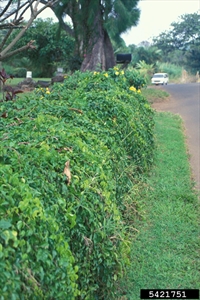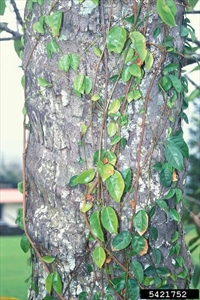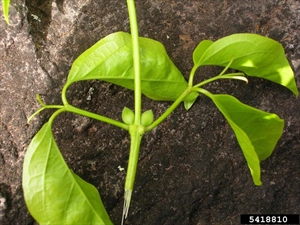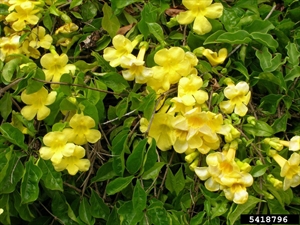Cat's claw creeper. It is also known as cat's claw vine, funnel creeper, yellow trumpet vine.
Pacific Pests, Pathogens, Weeds & Pesticides - Online edition
Pacific Pests, Pathogens, Weeds & Pesticides
Cat's claw creeper (499)
Macfadyena unguis-cati; previously, it was known as Bignonia unguis-cati, Dolichandra unguis-cati, and Doxantha unguis-cati.
Asia, Africa, North, South and Central America, the Caribbean, Europe, Oceania. It is recorded from Australia, Cook Islands, Federated States of Micronesia, French Polynesia, Guam, New Caledonia, New Zealand, Niue, and Vanuatu. It is a native to Mexico, South America and the Caribbean.
An aggressive, invasive vine growing in most soil types, although best in fertile, well-drained land. Weediness assisted by climbing woody stems that cling to tree trunks, an ability to grow in full sunlight and under forest shade and formation of tubers and stolons at nodes. A weed of grasslands, secondary and primary forests, orchards and gardens, roadsides, and along banks of streams and rivers (Photo1). In forests, dense mats form, smothering trees and shrubs. From sea level to 600 masl.
The creeper has a young stage with small leaves and vine which grows over the soil seeking a tree to climb (Photo 2). The mature stage, with the formation of tubers occurs in the second year, and flowering occurs later still when it becomes established. Vines are woody, growing up to 20 m long and 8 cm diameter (Photo 3). When mature, leaves are opposite along the vines, each with two leaflets, oval, 5-15 cm long, ending in a three-pronged tendril (the 'cat's claw' for attachment) (Photo 4). Flowers single or in pairs, bright yellow, trumpet-shaped, 4-8 cm, growing from the axils of leaves on stalks, 2 cm long, with green 5-lobed structure behind (calyx) (Photos 4-6). Seedpods are long and narrow, 15-45 cm and 8-12 mm wide, containing many two-winged brown seeds. Roots are branched with tubers along their length, up to 40 cm; each can produce multiple stems.
Short-distance spread is via rooting at nodes where vines touch the ground, and sprouting of tubers. Long distance spread is via seed on the wind, and also in water. Considered an ornamental and widely distributed by the international horticultural trade.
Considered a very important environmental weed in native forests and along banks of waterways in Queensland and New South Wales, Australia. Such is its severity that it is prohibited to grow it in parts of Florida. It is able to form dense layers over forest floors, outcompeting understory plants, climbing to the top of trees, spreading over their canopies, and killing them.
An ornamental, often planted to screen fences or building. In folk medicine, reported to have anti-malarial, and anti-tapeworm properties.
BIOSECURITY
The chances of introduction of cat's claw creeper is high. Countries not yet infested should consider all likely pathways for entry, and apply quarantine measures accordingly. Particular attention should be given to its trade internationally as an ornamental plants.
Macfadyena unguis-cati is on the Global Invasive Species Database (2021) of information on alien and invasive species that negatively impact biodiversity, managed by the Invasive Species Specialist Group of the IUCN Species Survival Commission: (http://www.iucngisd.org/gisd/speciesname/Macfadyena+unguis-cati). Seeds are available for purchase on the Internet.
BIOLOGICAL CONTROL
A leaf-eating beetle, Charidotis auroguttata, has been released in South Africa. Two biocontrol agents have been released in Australia: the leaf-sucking tingid, Carvalhotingis visenda, and a jewel beetle, Hylaeogena jureceki. The latter is being released in Australia.
CULTURAL CONTROL
- Physical & Mechanical:
- Hand-pulling is possible for small infestations, as long as all stems, roots and tubers are also removed, and disposed of appropriately so they will not regrow.
- Slash infestations - same conditions as for hand weeding above.
- Hygiene:
- Treat vehicles and farm machinery. If moving from areas where the weed occurs to those weed-free, wash to remove soil. This is equally important if the machinery is being imported into a country or moved within a country.
CHEMICAL CONTROL
In Australia, minor use permits allow the use of: glyphosate; triclopyr + picloram; and picloram + aminopyralid. There are two methods of application: foliar spray or cut-stump (cut at ground level, and painted immediately with undiluted herbicide). Herbicides are applied when the vines are growing actively.
--------------------
Note, EU approval to use glyphosate ends in December 2022; its use after that date is under discussion.
____________________
When using a pesticide, always wear protective clothing and follow the instructions on the product label, such as dosage, timing of application, and pre-harvest interval. Recommendations will vary with the crop and system of cultivation. Expert advice on the most appropriate herbicides to use should always be sought from local agricultural authorities.
AUTHOR Grahame Jackson
Information from PIER (2013) Macfadyena unguis-cati (L.) A.H.Gentry, Bignoniaceae. Pacific Island Ecosystems at Risk (PIER), Institute of Pacific Islands Forestry. (http://www.hear.org/pier/species/macfadyena_unguis-cati.htm); and CABI (2019) Dolichandra unguis-cati (cat's claw creeper). Invasive Species Compendium. (https://www.cabi.org/isc/datasheet/9159); and from Cat's claw creeper (Dolichandra unguis-cati) (2018) NSW WeedWise. Department of Primary Industries, NSW Government. (https://weeds.dpi.nsw.gov.au/Weeds/CatsClawCreeper). Photos 1-6 Forrest & Kim Starr, Starr Environmental, Bugwood.org.
Produced with support from the Australian Centre for International Agricultural Research under project HORT/2016/185: Responding to emerging pest and disease threats to horticulture in the Pacific islands, implemented by the University of Queensland and the Secretariat of the Pacific Community.









